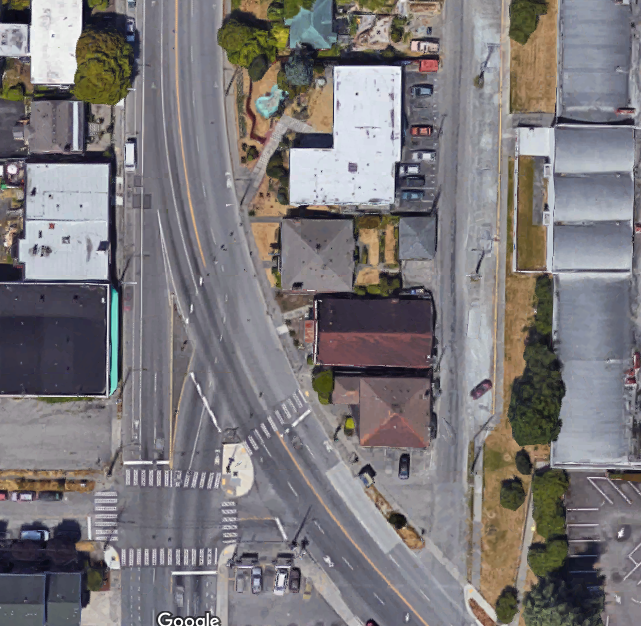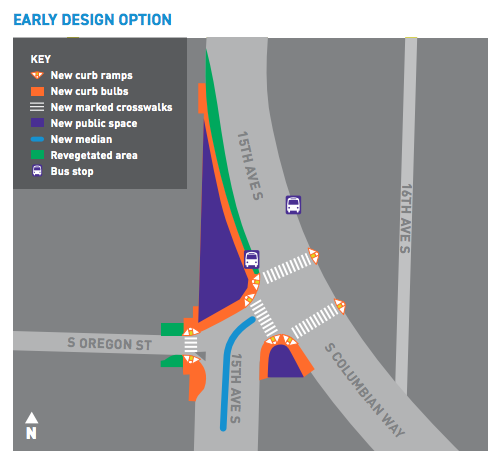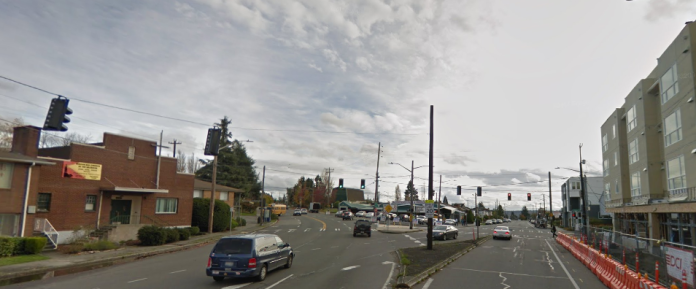Throughout 2016, I covered the process that led to the selection of twelve neighborhood-focused transportation improvements though the Neighborhood Street Fund process. Those concepts are all getting designed this year to be constructed next year, and were all vetted through both the District Neighborhood Councils and the Move Seattle Levy Oversight Committee, and approved by the city council for inclusion in the two-year budget.
Almost all of the projects are moving along on the path to 100% design, but one of the projects is running into some headway from neighbors who are not happy with some of the traffic impacts the project may have on the area.
The project in question is supposed to fix the intersection on Beacon Hill where Columbian Way, a fast busy thoroughfare, meets 15th Ave S, also a well-used arterial. Because Columbian Way intersects 15th at a curve, there is a very wide three-way intersection created that is hazardous to navigate safely on foot, not to mention by bike.

This intersection is very close to Mercer Middle School, located a block away. The fix proposed would rechannel traffic into fewer lanes, add a south crosswalk on Columbian Way, and use the excess space in the road to create a public plaza. The plaza is not the primary purpose of the project, but simply a byproduct of reallocating an overabundance of roadway to slow down traffic.

What is making some Beacon Hill residents unhappy with the project is that after the change, drivers would be prohibited from making a left turn from S Oregon St onto Columbian Way in either direction like they can now, instead forcing drivers to take a right onto 15th Ave S.
In response to this concern, the Seattle Department of Transportation (SDOT) has proposed adding a four-way stop sign at the intersection of Columbian Way and S Snoqualmie St (south of the intersection), so that drivers could be able to easily get onto Columbian Way northbound if necessary.
It does not appear to be enough to appease some residents. Several months ago, a rumor circulated that some neighbors were exploring ways to torpedo the street improvement. This week, a post appeared on the Facebook Group Beacon Hill, Seattle that seemed to have a plan to throw an impediment in the way. The post starts:
I am working against the SDOT proposal for the 15th Ave So. and So. Oregon Intersection. Below is my strategy which requires assistance from residents of the area…
The author of the post, who I will not name here, goes on to describe a search for a notable figure to pin a historic designation on with the intention of preserving the intersection in amber. The historic figure is Alan Sugiyama, who was the first Asian-American person elected to the Seattle School Board and was the founder of the Center for Career Alternatives, an organization that shuttered in 2011 and was last based out of an office on Rainier Avenue. Mr. Sugiyama lived nearby the intersection at Oregon and Columbian, and despite the proximity to Mercer Middle School there is no direct connection between his history and the place where those two streets come together. Alan Sugiyama by all accounts was a pillar of the South Seattle community for many years, having passed away just this past January, and a mentor to many people, but if a historic marker noting his life was motivated primarily by anger about a street safety project being implemented by the City that seems very problematic.
The Northwest Asian Weekly reports that the campaign to designate the street for Mr. Sugiyama is gaining supporters: Bruce Harrell has signed on to getting a memorial installed by September 10th, Alan’s birthday. To be clear, an honorary street name and plaque designation would be completely separate from a historic landmark designation. In order for the intersection to quality for landmark status, it would have to meet one of the rigorous criteria, in this case Criteria B:
b) It is associated in a significant way with the life of a person important in the history of the City, state, or nation
The standards for landmarks to be preserved under Criteria B are narrow: for example while Garfield High School is a city landmark, it is not because of any notable students who attended the school, like Jimi Hendrix, because it was not instrumental in them becoming who they are. An intersection that was simply used by a historic figure clearly does not meet the threshold. Seattle has several of landmarked streets, mostly associated with the Olmsted Boulevard network, so a street receiving a designation is not totally unprecedented but this case would clearly not meet the city’s threshold.
A memorial for Alan Sugiyama, if the community is pushing for it in good faith, sounds like a wonderful thing to add to Beacon Hill. It remains to be seen, however, if the Seattle Department of Transportation will carry through with its plans for the Oregon and Columbian Intersection after the amount of pushback they have gotten from community members about it. It is interesting to see an improvement that was so emphatically approved by both the District Neighborhood Council (a frequent topic of conversation during this mayoral election) and the Move Seattle Oversight Committee. Surely a compromise in this case is possible while still achieving the safety outcomes that everyone wants.
Ryan Packer has been writing for The Urbanist since 2015, and currently reports full-time as Contributing Editor. Their beats are transportation, land use, public space, traffic safety, and obscure community meetings. Packer has also reported for other regional outlets including BikePortland, Seattle Met, and PubliCola. They live in the Capitol Hill neighborhood of Seattle.


